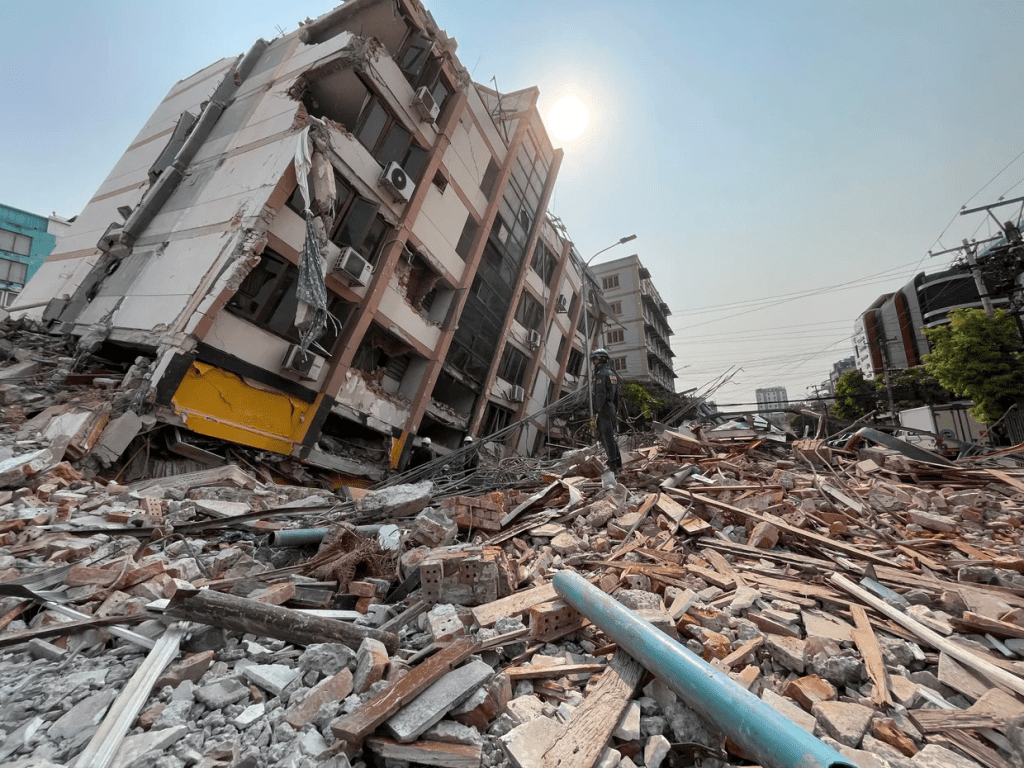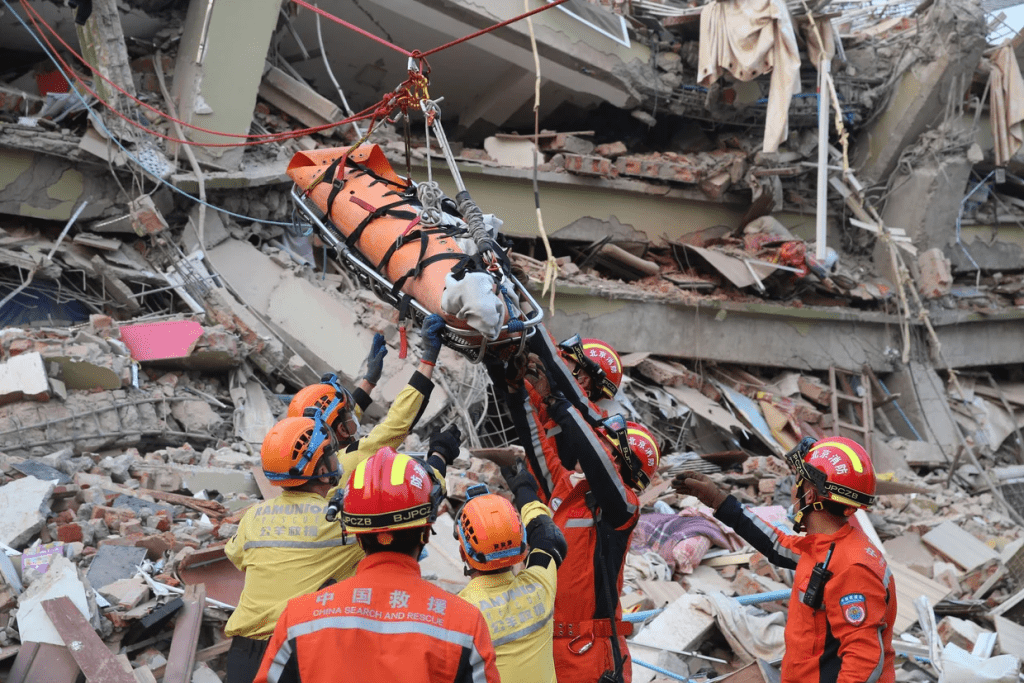
Bangkok — Rescue workers saved a 63-year-old woman from the rubble of a building in Myanmar’s capital on Tuesday, but hope was fading of finding many more survivors of the violent earthquake that killed more than 2,000 people in the country, compounding a humanitarian crisis caused by a civil war. The leader of Myanmar’s ruling military junta said on state television Tuesday that it was assumed the death toll would exceed 3,000, according to the Reuters news agency. General Min Aung Hlaing said there are at least 441 people still missing after Friday’s 7.7 magnitude quake. Any hope of finding survivors was dwindling quickly, the U.N.’s Office for the Coordination of Humanitarian Affairs warned on Tuesday. “The time window for critical search and rescue is narrowing,” OCHA’s Humanitarian Coordinator for Myanmar, Marcoluigi Corsi, told reporters in Geneva via video link from Yangon. “Shelter, clean water, and medicine are in short supply. People in affected areas spent the night in the open because there is no electricity or running water.”

“The needs are immense, and they are increasing by the hour,” stated Julia Rees, UNICEF’s deputy representative for Myanmar. “The timeframe for life-saving assistance is dwindling. Families in the impacted regions are grappling with severe shortages of clean water, food, and medical supplies.”
The World Health Organization has reported that more than 10,000 buildings in central and northwest Myanmar collapsed or sustained severe damage due to the recent earthquake, which also affected neighboring Thailand. In Bangkok, the earthquake caused a high-rise building under construction to collapse, trapping numerous workers beneath the rubble. While two bodies were recovered on Monday, many others remained unaccounted for. The earthquake resulted in the deaths of 20 individuals and left 34 injured in Bangkok, primarily at the construction site. Questions have been raised regarding the collapse of the skyscraper, prompting officials to launch an investigation to determine whether design flaws, substandard materials, or inspection failures may have contributed to the incident. In Myanmar, search and rescue operations momentarily paused on Tuesday as a mark of respect for the deceased. A woman aged 63 was miraculously rescued in Naypyitaw after being trapped under the debris of a building for 91 hours following the earthquake, highlighting the diminishing chances of finding survivors beyond the 72-hour mark. The fire department in Naypyitaw reported rescuing 403 individuals in Mandalay, Myanmar’s second-largest city, while the remains of 259 individuals have been recovered thus far. Tragically, a group of 50 Buddhist monks lost their lives when the monastery where they were taking a religious exam collapsed; 150 more individuals are believed to be buried under the rubble as of Tuesday. International aid workers have begun arriving in the affected areas to assist with rescue operations, although progress remains sluggish due to a shortage of heavy machinery in some locations.

The official Global New Light of Myanmar, a publication of the Myanmar military government, reported on Tuesday that a team of Chinese rescuers successfully saved four individuals from the ruins of the Sky Villa, a large apartment complex that collapsed during the earthquake. Among the rescued were a 5-year-old child and a pregnant woman who had been trapped for over 60 hours. Additionally, two teenagers managed to crawl out of the rubble using their cellphone flashlights to guide them to where the rescue crews were operating. The information provided by the teenagers helped the workers locate their grandmother and sibling. Various international rescue teams, including those from Russia, China, India, the United Arab Emirates, and several Southeast Asian countries, are currently active at the scene. The U.S. Embassy confirmed that an American team has been dispatched but has not yet arrived. Several countries have pledged substantial financial aid to support Myanmar and humanitarian organizations in the challenging task that lies ahead.
U.N. agencies have raised the alarm about the shortage of drinking water, with concerns about the spread of cholera. Many people in Myanmar were already lacking basic medical care and standard vaccinations before the earthquake, and the destruction of water and sanitation infrastructure has increased the risk of disease outbreaks.
“It is really dire – the most immediate need is water, it is super hot out there… Water pipes and septic tanks have broken,” said Julia Rees, UNICEF’s Deputy Representative, via the video link. Shelter is also a major problem, especially with the monsoon season looming. Earthquake compounds misery of Myanmar’s civil war. Even before the earthquake, more than 3 million people had been displaced from their homes by Myanmar’s brutal civil war, and nearly 20 million were in need, according to the U.N. Myanmar’s military seized power in 2021 from the democratically elected government of Aung San Suu Kyi, sparking what has turned into significant armed resistance and a brutal civil war. Government forces have lost control of much of Myanmar, and many places were dangerous or impossible for aid groups to reach even before the quake. Military attacks and those from some anti-military groups have not stopped in the aftermath of the earthquake, though the shadow opposition National Unity Government has called a unilateral ceasefire for its forces. The NUG, established by elected lawmakers who were ousted in 2021, called for the international community to ensure humanitarian aid is delivered directly to the earthquake victims, urging “vigilance against any attempts by the military junta to divert or obstruct humanitarian assistance.” “We are in a race against time to save lives,” the NUG said in a statement. “Any obstruction to these efforts will have devastating consequences, not only due to the impact of the earthquake but also because of the junta’s continued brutality, which actively hinders the delivery of lifesaving assistance.” It wasn’t immediately clear whether the military has been impeding humanitarian aid. In the past, it initially refused to allow in foreign rescue teams or many emergency supplies after Cyclone Nargis in 2008, which resulted in well over 100,000 deaths. Even once it did allow foreign assistance, it was with severe restrictions.”
“In this instance, the leader of Myanmar’s military junta, Senior Gen. Min Aung Hlaing, specifically stated on the day of the earthquake that the nation would welcome outside assistance. Tom Andrews, a United Nations-appointed monitor on human rights in Myanmar, highlighted that in order to facilitate aid, military offensives must cease. He stressed, “The priority in Myanmar should be to save lives, not end them.”


